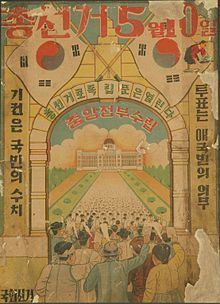Start date May 10, 1948 | ||
 | ||
Constitutional Assembly elections were held in South Korea on 10 May 1948. It was held under the American military occupation, with supervision from the United Nations. It resulted in a victory for the National Association for the Rapid Realisation of Korean Independence, which won 55 of the 200 seats, although 85 were held by independents. Voter turnout was 95.5%.
Contents
Background
The elections were an important milestone in Korean political history. The Korean people had not previously experienced written constitutional rule; the very foundation of South Korean politics were still under construction and were unstable. The Korean peninsula had not yet established a fully functioning democratic republic, this was the first step in that direction. The elections would lead to a constitution,roughly based off the constitution of the United States of America; and bring with it the modern democratic state like that of the countries of the United Nations.
The elections did not come without controversy. In 1948, the subject of an election of any kind in South Korea was an issue worldwide. On 8 and 9 March 1948, UN delegates from Australia, Canada, India, and Syria expressed their doubts and some complete rejection of the elections on 10 May 1948 for South Korea. The U.N. delegates were concerned of Korea's political maturity at the time, feeling that the elections might not validly express the popular will after only being an independent country for four years. There were even Korean politicians, such as Kim Koo and Kim Kyu-sik, who denounced the election as it would dash the hopes of reunification with North Korea. However, with the voting out come from the South Korean Interim Legislature a 40 to 0 in favor of the election on 10 March, there was little reason to postpone or do away with the election at that time.
Controversy within the peninsula itself against the elections were just as negative. The elections were originally intended to be held throughout the Korean peninsula, but Soviet Union forces and Kim Il-sung refused the UN superviors entry into North Korea for the elections. They were therefore held only in the US-administered territory, making the elections a purely South Korean event. Because of the segregation for the elections, Kim Koo and Kim Kyu-sik, denounced the elections as they would dash the hopes of reunification with North Korea. However the elections went ahead regardless of the doubts placed upon it. The voters elected members of parliament, who then voted on the constitution and elected the president. at the proceedings, they left one hundred seats open in the South Korean Parliament for North Koreans to vote on when they were able.
Results
The elections were marred by terrorism resulting in 600 deaths between March and May. In April, North Korea, supposedly in an effort to delay the elections, sponsored a unity conference in Pyongyang to promote reunification of the two Koreas. Both Kim Koo and Kim Kyu-sik attended the conference. The conference was inconclusive towards any upcoming reunification, and the conference did not delay the elections on 10 May of that year. Not all South Koreans supported the elections either, as stated before that Kim Koo and Kim Kyu-sik were against it from the beginning. and eventually both boycotted the elections. The people of Jeju island, Jeju island people, saw the election as a unilateral attempt of the United States military government under the flag of United Nations to separate a southern regime and to employ its first president Syngman Rhee, but police fired and killed Jeju demonstrators. Then April 3 uprising occurred, tens of thousands of Jeju people were killed by South Korean officials and right wings. Though these elections were not intended to be separate elections from the North Korean republic, and regardless of the negativity from the U.N. and the Korean public, or the bloodshed discontent that resulted from these elections, it is still the first time in Korean history that the citizens were allowed to vote for a national legislative body, for prior to 1945 the Korean peninsula had been under Japanese colonial rule for thirty-five years (1910–1945), and for thousands of years before Japanese rule, the peninsula was governed by the (Yi Dynasty) Korean royal family and scholarly officials.
